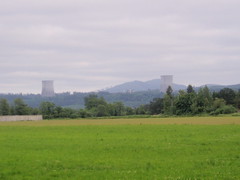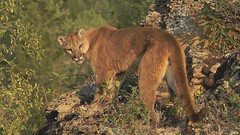The A, B and G lines north of Brady, WA
I recently had the fortune to be taken on a personal tour of the Weyerhauser logging areas north of Brady, WA. I’ve been more and more interested in hunting as of late, and a coworker of mine – an avid hunter since he was a teenager – was kind enough to take me on a scouting trip to the area where he hunts every year.
Being completely unfamiliar with anything having to do with hunting (though I’m educating myself as best as I can…even took Washington State’s online hunter education and safety course and scored 100% on the practice test), I jumped at the chance to spend four hours with an experienced hunter as he looked for good locations and familiarized himself with the terrain. Though he’s been hunting the area with his father for probably close to 30 years, because it’s land owned and logged by Weyerhauser, parts of it are constantly being clearcut for timber and replanted. In fact, my guide showed me areas of 20- to 30-foot tall trees that were clearcut when he was a kid.
 The land is located north of Brady, a small town’s small town just off Highway 12 between Olympia and Aberdeen. If you’ve driven the stretch, you know it from its distinctive landmarks…two cooling towers from the abandoned Satsop Nuclear Plant which dominate the southern skyline for miles. About midway through the valley, just past Elma and before Montesano (the county seat of Grays Harbor County) is a turnoff – not even an exit – to Brady. Half a mile later and you’re at the Brady Food Mart where our trip began.
The land is located north of Brady, a small town’s small town just off Highway 12 between Olympia and Aberdeen. If you’ve driven the stretch, you know it from its distinctive landmarks…two cooling towers from the abandoned Satsop Nuclear Plant which dominate the southern skyline for miles. About midway through the valley, just past Elma and before Montesano (the county seat of Grays Harbor County) is a turnoff – not even an exit – to Brady. Half a mile later and you’re at the Brady Food Mart where our trip began.
It was a hot and sunny Sunday afternoon. After Kelly, Parker and I got out of church I said my goodbyes and made the hour-or-so-long trek west of Olympia, first on the 101, then the 8, then the 12. I met Kevin at what he described as the “mom and pop” store, but what I found to be more of a “mama-san papa-san” store (if you catch my drift). Since I arrived early, I asked to use their restroom. The lady behind the counter asked me, “You something buy?” After I made it clear that I intended to buy something, she pointed me in the direction of the restroom.
After Kevin arrived, we hopped in his truck and headed north on Middle Satsop Road for about five miles. As we drove, he’d point out all the fields where he’s spotted herds of elk or deer over the years. Then suddenly, we hit the brakes and took a sharp left onto a dirt road with a open yellow gate. As we passed, Kevin pointed out the silver-dollar sized yellow dot on the sign and slowed to give me time to read it. Essentially, it said the land was owned by the paper company and hunting would be allowed in season only according to the color-coded system.
For the next four hours, we traveled along the logging roads as Kevin doled out more and more information about hunting, the area we were in, the kinds of wildlife you’d expect to find, and an occasional hunting story (which I found weren’t that different from a lot of fishing stories I’ve heard). The main logging road is called “A-Line” and each offshoot of that road is labeled “A100,” “A200”, etcetera.
At one point, we reached the intersection of A-Line and “B-Line,” a long, circuitous path that took us even farther to the northwest. B-line’s offshoots were labeled the same…”B-100,” “B-200” and so forth. Kevin explained that the system was designed so that if the company made a new logging road between A-100 and A-200, they’d call it “A-150,” which made sense.
We also came across “G-Line” (I never did see a C-through-F-Line) which Kevin found to be open, a first in nearly a decade of utilizing the area. We took the opportunity to trek through some new territory as Kevin made mental notes about where he might want to try hunting when the season comes. Though the sun was quite hot, we’d pull his truck to the top of a ridge that over looked a clearcut and get out of the car for 10 or 15 minutes. Each of us would take a seperate position at the ridge’s edge and “glass” the area (slowly scan it with binoculars) looking for any sign of movement. Kevin said we likely wouldn’t see any deer that day (which we didn’t) but when the season was in full swing, you might catch a tail swish or an ear flapping if you were lucky, patient and very, very still.
 Another thing he pointed out was all the tracks in the areas we stopped. Deer tracks and scat, elk tracks (some pretty fresh) and even a cougar track or two. Hard to believe all that activity was taking place on what used to be the site of a noisy logging operation! About two-thirds of the way through our scouting trip, we pulled into a gravel pit the company uses to make new roads and popped off a few rounds with Kevin’s .30-06 rifle. While it was quite a thrill to shoot, it didn’t compare to Lyn Hartman’s .45-70 Government that I fired a few months back! Kevin also let me fire his (what we soon discovered to be a) semiautomatic .22LR. A friend of his wanted to sell it to him and he wanted to test it out first. It was an older rifle and it took us a few minutes and test fires before I discovered that it was a single-shot repeater. Very fun to cap off eight rounds as quick as you can!
Another thing he pointed out was all the tracks in the areas we stopped. Deer tracks and scat, elk tracks (some pretty fresh) and even a cougar track or two. Hard to believe all that activity was taking place on what used to be the site of a noisy logging operation! About two-thirds of the way through our scouting trip, we pulled into a gravel pit the company uses to make new roads and popped off a few rounds with Kevin’s .30-06 rifle. While it was quite a thrill to shoot, it didn’t compare to Lyn Hartman’s .45-70 Government that I fired a few months back! Kevin also let me fire his (what we soon discovered to be a) semiautomatic .22LR. A friend of his wanted to sell it to him and he wanted to test it out first. It was an older rifle and it took us a few minutes and test fires before I discovered that it was a single-shot repeater. Very fun to cap off eight rounds as quick as you can!
Eventually, our B-Line reconnected with the A-Line and we headed back to the food mart. While we didn’t see any wildlife that day – short of a few squirrels and a hawk or two – I’m sure hoping he invites me back out to the area again. And maybe next time I’ll have my own rifle, a license and little luck!
View Brady, WA in a larger map

Loved this blog post by my son, Erich!